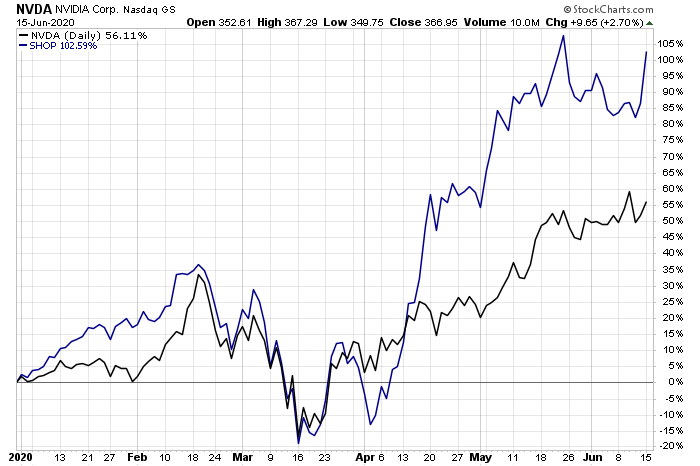Why Tech Stocks Are Soaring Despite the Economic Downturn
Marijuana Business, Stocks, Finance, & Investing June 16, 2020 MJ Shareholders 0


The Resilience of Tech Stocks
And we’re back. It’s been a while, dear reader, but we here at Profit Confidential are back up and running again and we’re happy to bring you some of the hottest stock picks (including tech stocks) on the market right now.
You may be thinking… “Stock picks right now, with the market as tumultuous as it is? Isn’t that crazy?”
While this may seem intuitive, I’m actually here to point out a number of stocks that have proven time and again to be resilient to economic slowdowns…namely, tech stocks. And, more specifically, tech stocks in huge growth markets.
Now, let’s get a few things out of the way at the start.
By saying these stocks are “downturn-resilient” or even “depression-resilient,” this doesn’t mean that these stocks are impervious to losses. No company is. But what it does mean is that economic slowdowns—particularly the massive ones we’ve experienced over the past two decades—have had little to no long-term impact on the growth rate of these types of tech stocks. And that growth rate is, and has been, exponential.
To understand why, you have to examine what makes these companies so special.
While the top tech stocks that have proven resilient through these economic slowdowns operate in a variety of subsectors—from social media to hardware to SaaS—what links them all is the growth outlook of their markets. Which is another way of saying that each of these companies had, both before and after the economic downturns, massive runway to see increases in customers and revenue for years to come.
As we all know, Wall Street is a marketplace built on the idea of growth as a religion. It’s the reason we see so many companies valued in the billions that have never made even a single cent in profit; they simply have enough growth in their projections to justify those massive valuations, with the implication that one day (hopefully sooner rather than later) the growth will pay off with huge dividends.
These growth projections for their markets are static, meaning that they will hold regardless of whether the economy faces a temporary collapse. The “use cases” of these products are projected to exponentially grow, because our technology is simply steering us in that direction irrespective of the peaks and valleys of the stock market.
Honestly, it’s a good rule of thumb in general to find companies that promise huge growth rates (with the appropriate data to back it up, of course, instead of pie-in-the-sky, baseless projections), because these are often the companies that see the largest and fastest growth periods. It doesn’t even matter if they can pay off, in some instances; get in early enough and you could end up making a killing.
And with all that preamble out of the way, we can get down to the top tech stocks equipped to weather economic downturns.
Top Tech Stocks in an Economic Downturn
As mentioned above, there are entire industries that have proven resilient to stock market crashes, and you can find many good stocks out there right now with huge potential for double-digit returns (and you can expect me to cover them as the year goes on). But the two I’ve selected here are representative of two distinct industries that are both set to see huge gains in the years to come.
Chart courtesy of StockCharts.com
NVDA Stock
This top stock is a company that I’ve been covering for a long time now. Pretty much since I began working at Profit Confidential several years ago. It was a great tech stock for my readers then, and it would be a great tech stock to consider now.
NVIDIA Corporation (NASDAQ:NVDA) is primarily a graphics processing unit (GPU) manufacturer, typically for use in high-end gaming computers. But that’s the old NVIDIA.
NVIDIA stock’s future will focus on a much larger fish: artificial intelligence (AI). A significant part of the AI market will rely on cutting-edge GPU technology…and, in that arena, NVIDIA is unrivaled.
Consider what I wrote above once more: there is probably no industry more likely to see massive growth in the near future than the AI industry.
McKinsey & Company estimates that, in 2020, we could see AI and machine learning create up to $2.0 trillion in value in manufacturing and supply chain planning, as well as $2.6 trillion in marketing and sales. (Source: “Roundup of Machine Learning Forecasts and Market Estimates for 2019,” Forbes, March 27, 2019.)
Given that those numbers will have to be heavily reconsidered post-coronavirus, the fact remains that there is a huge swell of momentum building behind the AI industry.
Furthermore, economic downturns aren’t really able to slow these operations, because they are largely funded by billion-dollar corporations with a lot of cash on hand with plans to reach market on timescales of, in some cases, decades. The year-to-year performance of the stock market is, ultimately, irrelevant when you’re operating on literally trillions of dollars in potential market growth and with the projections in this case being larger than in most industries.
Now, don’t be misled by that timescale; just because the product may not reach its potential for a decade or two doesn’t mean an investor will have to wait that long to see returns on their investment.
In fact, NVIDIA has consistently seen strong growth (up about 180% over the past three years). This year has proven no different, with gains of about 56% year-to-date.
After all, we’re talking about a potential multi-trillion-dollar industry growing from almost nothing. The AI market isn’t just big business; it’s the biggest business there is.
LinkedIn’s “2020 Emerging Jobs Report” named “artificial intelligence specialist” as the job that saw the most growth in the previous five years—when comparing different jobs’ hiring growth rates every year averaged out. (Source: “2020 Emerging Jobs Report,” LinkedIn, last accessed March 20, 2020.)
As a result, it stands to reason that AI stocks have some of the biggest potential in the world to see huge gains.
And NVIDIA stock has not let us down in that regard, economic downturn or no.
The company’s most recent quarterly report had its revenue up to $3.08 billion, a 39% jump from $2.22 billion a year earlier. It’s down only one percent from the previous quarter’s $3.11 billion, all the more impressive considering this period accounts for the huge economic slowdown we experienced in early 2020. (Source: “NVIDIA Announces Financial Results for First Quarter Fiscal 2021,” NVIDIA, May 21, 2020.)
SHOP Stock
Another top tech stock—operating in a totally different industry—that should have you excited is Shopify Inc (NYSE:SHOP).
As an ecommerce company, you’d anticipate that SHOP stock would see huge gains, as that sector has exploded in value over the past couple of decades. But here’s the thing: while companies like Amazon.com, Inc. (NASDAQ:AMZN) suck up all the oxygen in the media (both for good and ill), Shopify stock has quietly amassed one of the strongest runs in recent history on the stock market.
Having gone public in May 2015, the company has since seen its value absolutely swell by an astounding 4,600%! To that end, for every $100.00 someone invested in SHOP stock back in 2015, they could have made $4,600.00. That’s an impressive rate of return.
And the good times do not look like they’ll be slowing down for Shopify stock anytime soon. Because, while Amazon and others duke it out over direct sales to consumers, Shopify found a more niche-focused but similarly lucrative way to profit from the ecommerce boom: by providing resources for vendors.
Essentially, Shopify is an ecommerce platform that helps vendors access the ecommerce market more effectively, handling things like marketing, payments, shipment, etc.
That has proven to be a great business to get into as evidenced by the company’s huge gains.
Furthermore, Shopify stock shows no signs of slowing down, as we can expect to see the ecommerce market continue to balloon, especially following this particular economic downturn, brought on, as it was, by a virus.
SHOP stock has, much like NVIDIA stock, strong numbers to support its claim as to being one of the top tech stocks in 2020.
The company saw total revenue climb in its most recent quarterly report to $470.0 million, a 47% increase from the same period in 2019. Subscription solutions revenue also grew 34% to $187.6 million, showing that the company’s growth phase is far from over. (Source: “Shopify Announces First-Quarter 2020 Financial Results,” Shopify, May 6, 2020.)
And the company is projecting that the ecommerce sector will be worth nearly $5.0 trillion come 2021, meaning that there’s still a whole lot of room for growth this year.
What’s more, economic downturns have been unable to derail the gains made in the ecommerce sector. Quite the contrary, the industry seems to expand in these periods, as people are more money-conscious and therefore seek out the best deals, typically found online.
Analyst Take
The top tech stocks have proven to be fabulously resilient to the turbulence experienced on the stock market. This is a trait that is frankly invaluable to investors looking to make large returns while not being overexposed to risk.
In that regard, few companies can fare better than Shopify and NVIDIA. Both NVDA stock and SHOP stock have proven to be powerful growth stocks for investors and, economic downturn or no, both seem to be on the rise once again.
MJ Shareholders
MJShareholders.com is the largest dedicated financial network and leading corporate communications firm serving the legal cannabis industry. Our network aims to connect public marijuana companies with these focused cannabis audiences across the US and Canada that are critical for growth: Short and long term cannabis investors Active funding sources Mainstream media Business leaders Cannabis consumers












No comments so far.
Be first to leave comment below.